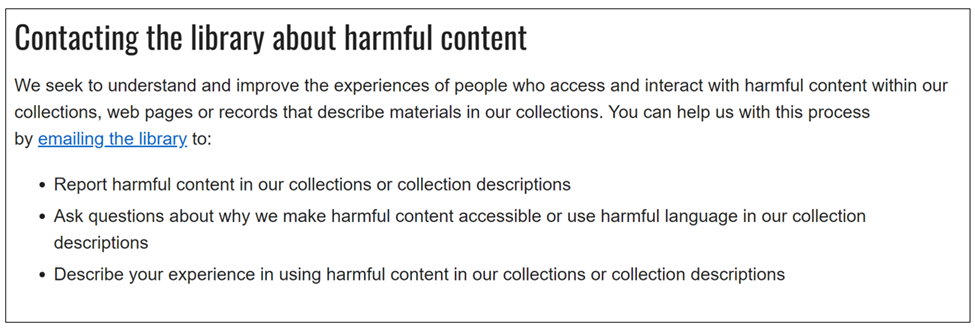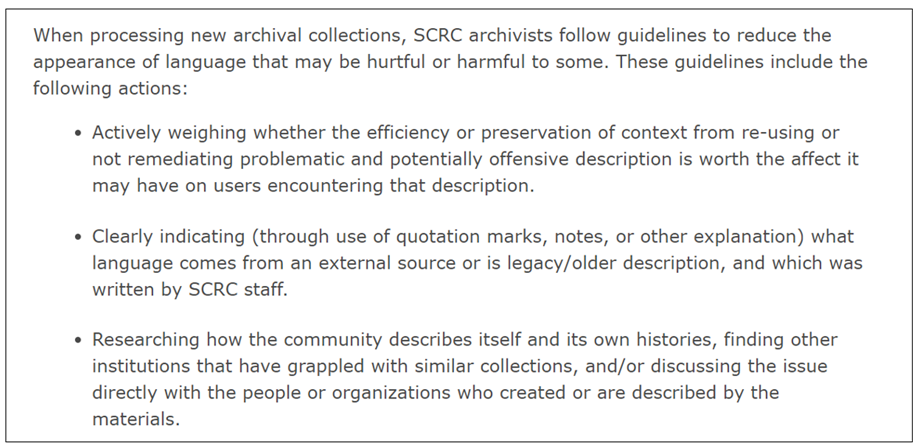By Lindsay Loebig, 2022 M.A. in Archives and Records Management graduate, University College Dublin
As archivists, our decisions in cataloguing can encourage or dissuade users from accessing collections. While archivists try to stay neutral in descriptive practice, bias, whether conscious or unconscious, still exists. This can be exhibited in our own word selection, creator language, or in controlled vocabularies found in thesauri like the Library of Congress Subject Headings.
Language is always changing. Words to describe individuals or communities once deemed acceptable can be offensive in its present form. This can impact user engagement of libraries and archives. The short documentary, Change the Subject, shares one example concerning the use of the term ‘illegal aliens’ instead of ‘undocumented immigrants’ in a library catalogue. Remediating language in catalogues can be a time-consuming and difficult task and is not always possible. How can archivists be cognizant of the impact descriptive language has on minority voices while still managing to keep these records accessible? One method is by creating a harmful language statement.
Within the past decade, social justice initiatives have emerged front-and-centre in archival practice through concepts like radical empathy and reparative description. Being more mindful of diverse users, some repositories are publishing harmful language statements to mitigate the harm their collections might provoke. These statements acknowledge the presence of harmful content in collections that reflect racist, sexist, ableist, xenophobic, homophobic, or other forms of biased views, and provide a message of understanding and explanation to users. While these statements are becoming more prevalent, there is limited research about them. I discovered this first-hand when tasked with describing a collection with derogatory language in one of my archiving course modules. This piqued an interest which led to it becoming the topic of my master’s thesis, exploring why and how these statements are created.
As part of my research, I analysed twenty-seven harmful language statements of U.S. university archives from a collated list comprised of American, Australian, and Canadian cultural heritage institutions’ statements on a website called Cataloging Lab, a space for cataloguers to discuss controlled vocabularies. I chose to focus on U.S. universities because of my background working in U.S. university student affairs and the broader number of statements available. Following the content analysis of the statements, I sent a questionnaire to six U.S. university archives to learn more about their motivations and approaches (You will find the links to the six university statements in point #5 below).
What did I learn from my research?
- Defining the term, harmful language statement, is harder than expected. There is no published definition (that I could find) and the term itself varies, being referred to as a statement, acknowledgement, policy, or guiding principles. While having a definition can be valuable for those new to the concept, many repositories do not find a fixed definition necessary to create a statement. It is more essential to define the systemic issues within descriptive practices and determine what is the best way to move forward rather than get stuck on the term itself.
- There is no explicit mention of harmful language statements in U.S. professional standards or codes of practice like Describing Archives: A Content Standard (DACS) or in the Society for American Archivists or the American Library Association’s code of ethics. This reflects the understanding that archivists have free will to follow or not follow professional recommendations. While not forthright about creating harmful language statements, these guidelines do encourage archives to be more inclusive and to mitigate harm. Guides for describing minority groups like the Protocols for Native American Archival Material and the Aboriginal and Torres Strait Islander Protocols for Libraries, Archives and Information Services do recommend archives address harmful content. From the UK/Ireland perspective, ARA Code of Ethics, point D.34, also suggests warning users of offensive material.
- Most U.S. university archives are motivated to create a harmful language statement due to social and professional motivators with social justice being the primary factor. The statements are just one step in a larger effort for social justice action in archiving. Many of the surveyed archives decided to create their statements after encountering potentially harmful deposits or creator descriptions, the murder of George Floyd and the Black Lives Matter movement, or the observance of public scrutiny of racist content in historical university yearbooks.
- Resources play a valuable role in the creation of the statements presenting opportunities to learn more about social justice trends and to provide guidance. A little more than half of the twenty-seven statements shared more than sixty resources between them. These included links to other harmful language statements, professional standards and codes of practice, academic articles, guides for describing marginalised groups, and institutional specific policies like diversity, equity, and inclusion plans. The two most cited resources are Temple University Special Collections Research Center’s harmful language statement and the Archives for Black Lives Matter in Philadelphia Anti-Racist Description Resources. While professional standards and codes of practice are cited multiple times in harmful language statements, they are rarely motivators to initiate the statement’s creation. Instead, they are referenced during the draft to ensure principles align.
- The statements themselves vary in length and content, ranging from short and simple to robust and comprehensive. Each university conveys their own message that best fits their repository. There are common elements found in these statements. These characteristics with excerpt examples are:
Explanation of Content
Explaining why harmful content exists in archives is the primary purpose of the statement, which can help users understand why this language exists and acknowledge the feelings it may evoke. Just like descriptions, these statements provide context. Below is how Stanford Special Collections and University Archives, Statement on Potentially Harmful Language in Cataloging and Archival Description, relays this message:

Form of Contact
Having a method for users to contact the repository to flag harmful content or provide feedback is a common practice in these statements. This is done through an email address or online form. University of Missouri-Kansas City Libraries, Harmful Content in Library and Archives Collections, encourages users to submit feedback.

Mention of Iterative Practice
As archivists, we strive to improve our methods though iterative practice. Twenty-one of the reviewed statements provided some sort of message that the repository is continually working to improve their praxis. Sometimes this is shared as a standout message in the beginning of the statement, while other times it is a subtle comment embedded in a sentence about accepting user feedback. The latter is usually presented as, “We welcome feedback so we can learn and adjust our practices.” Regardless of the grandeur of the messaging, repositories find it important to share with their audience that they are open to iteration and growing as a repository. Drexel University Libraries, Statement on Harmful Content in Archival Collections, includes this message toward the top of their statement.

Action Items
Repositories work to mitigate harm and improve their practice through various efforts like creating harmful language statements and other endeavours. Some repositories share these actions within their statements. Being transparent with plans requires repositories to develop specific actions to improve descriptive practices which hold them accountable. Some examples include using people-first language, working with relevant communities to create culturally sensitive descriptions, and identifying creator language with quotation marks. Temple University Special Collections Research Center, SCRS Statement on Potentially Harmful Language in Archival Description and Cataloging, share similar action items.

Acknowledgement That Archives are Not Neutral
Some harmful language statements have an acknowledgement that archives are not neutral or that descriptive practice is biased. Expressed through different wording, this lets the user know that archivists are not without faults but desire to learn and grow. University of Central Oklahoma Library, Inclusive Metadata Statement, was thoughtful in their word selection for this message.

Sharing Resources
Citing and sharing resources on the same webpage as the harmful language statement is a feature that some repositories choose. This allows readers to grow in their social justice knowledge and allows users to see what types of resources the repository is using to drive their descriptive practice. For example, Tufts University Archival Research Center, TARC Statement on Potentially Harmful Language in Archival Description, has a link to additional reading toward the end of their statement, which shares multiple resources for more socially just description.

Some final tips
Now that you know the why and what of harmful language statements, let’s end with the how. Confession- I haven’t drafted a harmful language statement of my own yet (I currently work in records management, and there isn’t much harmful language in aircraft leases), but I did gain some valuable insight from professionals who have written one. With that, I leave you with the following tips:
Do your homework. Explore other universities’ statements to get a sense of their makeup. Review the cited resources to better understand the role of social justice in archiving and the people that collections can impact. I initially entered my thesis thinking I could create a harmful language statement template but came to realise you can’t; each statement is unique. Make the statement your own that best reflects your institution and the purpose you are creating it.
Look at the bigger picture. Many of the questionnaire participants shared that drafting a harmful language statement was just one piece of their social justice efforts. As one participant shared, “It’s not a one-and-done problem, but rather one that requires constant, programmatic work.” Think about other strategies you will take to learn and grow as a professional to create a more inclusive environment.
Give yourself time to create your statement. The surveyed repositories shared that it took several months to a year to create their statement. This allowed them time to research other statements, align their goals and actions, and to streamline processes. Don’t be afraid to review your statement periodically and make updates if needed. Remember, being iterative is a good thing!
This blog is based on a talk given at the SfNP Research Showcase 2023
